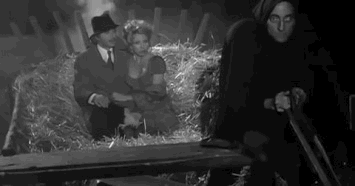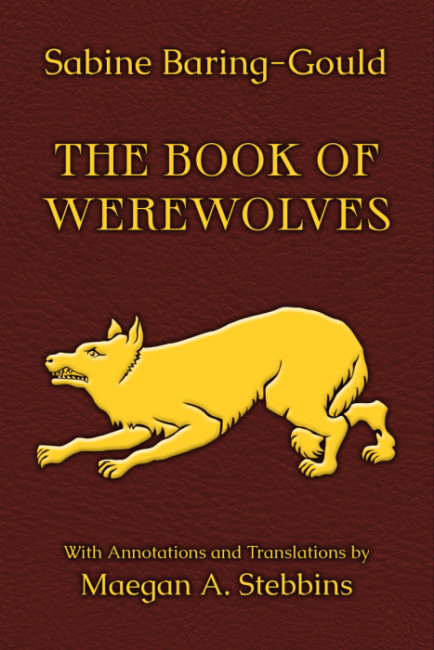While it may not be a “werewolf fact” of the traditional nature, it’s very important when studying folklore to know and understand one’s sources.

One of the very best sources for werewolf folklore – and indeed other folklore and mythology besides – is Sabine Baring-Gould’s The Book of Werewolves (or The Book of Were–Wolves as he called it), written in 1865. However, like any academic/rhetorical source, it shouldn’t be taken at face value. Let’s dive into why it’s such a useful source – and why you shouldn’t always take to heart everything Baring-Gould attempts to assert.
Already a scholar, Baring-Gould was a skeptical guy. It all began when, during his travels, Baring-Gould encountered several people terrified of a werewolf. He was baffled they truly believed in such a thing, and that it would stop them from wanting to traverse a road at night…
“If the loup-garou were only a natural wolf, why then, you see”—the mayor cleared his throat—“you see we should think nothing of it; but, M. le Curé, it is a fiend, a worse than fiend, a man-fiend,—a worse than man-fiend, a man-wolf-fiend.”
Baring-Gould, not intimidated, walked the road alone. However, along the way, the words of the others got to him, and he found himself frightened. The manner in which such preposterous superstition (naturally, he wasn’t exactly a believer) would actually make him afraid at all made him very curious about such things and why people would believe in them…
This was my first introduction to werewolves, and the circumstance of finding the superstition still so prevalent, first gave me the idea of investigating the history and the habits of these mythical creatures. I must acknowledge that I have been quite unsuccessful in obtaining a specimen of the animal, but I have found its traces in all directions. And just as the palæontologist has constructed the labyrinthodon out of its foot-prints in marl, and one splinter of bone, so may this monograph be complete and accurate, although I have no chained werewolf before me which I may sketch and describe from the life. The traces left are indeed numerous enough, and though perhaps like the dodo or the dinormis, the werewolf may have become extinct in our age, yet he has left his stamp on classic antiquity, he has trodden deep in Northern snows, has ridden rough-shod over the mediævals, and has howled amongst Oriental sepulchres. He belonged to a bad breed, and we are quite content to be freed from him and his kindred, the vampire and the ghoul. Yet who knows! We may be a little too hasty in concluding that he is extinct. He may still prowl in Abyssinian forests, range still over Asiatic steppes, and be found howling dismally in some padded room of a Hanwell or a Bedlam.
Baring-Gould has his biases, but he also has an open mind about some topics, even if he’s shut tighter than a bear trap on others, especially where anything scientific is concerned, as he was a big believer in the science of his time (not all of which is applicable to today). He’s a complicated bag of tricks, and reading his work is quite an experience.
Whatever his biases and whatever one might think of his occasionally very judgmental and overly authoritarian words (i.e., he can sometimes think he knows better than everyone, including the people who actually lived during the time periods he’s discussing), he is nothing short of phenomenal at his work of gathering and examining sources… even if he isn’t always right. He contradicts his own research at least once, namely in relation to berserkers, but I won’t go into all that (unless you read my edition of his book, of course; I discuss it extensively there).
He even spins some of his sources into thrilling tales. He honestly isn’t bad at narration, able to paint an impressive and thrilling picture when retelling various werewolf (and other) legends…
But when dusk settled down over the forest, and one by one the windows of the castle became illumined, peasants would point to one casement high up in an isolated tower, from which a clear light streamed through the gloom of night; they spoke of a fierce red glare which irradiated the chamber at times, and of sharp cries ringing out of it, through the hushed woods, to be answered only by the howl of the wolf as it rose from its lair to begin its nocturnal rambles.
Something to note with Baring–Gould is that some of his sources are actually no longer with us. They did clearly exist, and he could access them during his own time, but they’ve since been lost, especially in such original formats (or they might be gone altogether). This is just another reason why Baring–Gould‘s work is irreplaceable as a source for many, many fields, not just werewolf studies. He cites and discusses works about many kinds of folklore, mythology, and even history, and he even provided the first English translation of the trail of Giles de Rais, a famous killer (and basis for the fairy tale Bluebeard). It’s a fascinating read, even if you’re just there for general folklore and mythology or if you’re there specifically for werewolves or, broader spectrum, all manner of shapeshifters – he even talks a little bit about dragons!
However, when reading, bear in mind that Baring-Gould is not without his biases, as I mentioned before. He can be very judgmental of other scholars, especially from the past, but that isn’t exactly uncommon even in modern scholarship. It’s easy enough to read around, as long as you don’t take everything he writes as fact. No scholar is perfect, no matter how impressive their work is, and that certainly includes Baring-Gould. He also approaches his work with werewolves specifically with the determination to relate them to “madmen” and serial killers, which is a consistent theme throughout the book. He will discuss werewolf legends and detail them well, but toward the end of each section, when providing his own assessment, he will generally offer how such things could be rationalized in his own mind. In doing so, of course, he does offer interesting discussion and food for thought, regardless of whether you agree with him (I agree with him at times but can also find him very disagreeable; it’s like that with most everything one reads, so no shocker there). And, of course, his work even if only used for informational purposes is still impressive.
Biases is no reason to pass on what might be the best single source on these many topics. Besides, reading around potential biases is a skill everyone should learn.
One of his biggest downsides is that he doesn’t provide English translations of all his quoted passages and sources. This was a problem in the original publication from the 1800s, and it continues into today with nearly all editions…
However, if you do want translations of nearly all of his quoted passages from various sources (as well as extensive annotations discussing werewolf studies, mythology, and more, and putting his scholarship into a modern context and even pointing out his errors, such as when he contradicts himself), then you need to see my edition of his work!
I personally translated and annotated The Book of Werewolves this year, and it’s now available for purchase both through Amazon.com and my personal website, with a cover that’s a different take on the book’s original 1865 release…

Be sure to check it out at Amazon.com and here on my personal website!
If you buy it directly from me, I’ll sign it for you, too. You can also download an ebook.
I assure you it’s the best edition of this book you’ll find. I know because I’ve bought nearly all of them trying to find one that’s at all easy to reference. My edition even includes a bibliography that will assist you with further related reading, among other useful things. I’ve made sure the formatting is easily readable, so it’s good for both casual reading and citation/quotation in research/academic projects. This was a lot of work, and I’m very proud of how it turned out, especially as I myself have worked with this book for years.
Final words: even with all my own personal biases about werewolves, the study of werewolf and other legends, and my opinions on some of Baring-Gould’s assertions, I have to give Baring-Gould’s work a 10/10 for being a must-read for anyone interested in werewolves. Trust me – if you love werewolves and studying their folklore like I do, you won’t be able to put this book down, and you’ll walk away with far more knowledge than you had before. Reading this book alone will give you a decent foundational knowledge of werewolf studies, while also touching upon other fields.
However, of course, I do recommend reading mine. Obviously. Especially because Baring-Gould is just so wrong about berserkers (hence, my own assertions)! But anyway.
That’s all for now. Until next time, and be sure to check out my newsletter linked below!
( If you like my blog, be sure to follow me for more folklore and fiction, including books, especially on werewolves!
Free Newsletter — Patreon — Wulfgard — Werewolf Fact Masterlist — Twitter — Vampire Fact Masterlist — Amazon Author page )